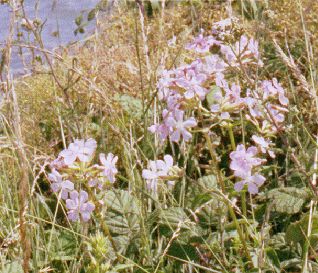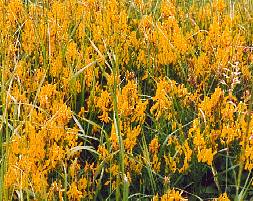 Milton Common is an area of 46 hectares south of Great Salterns Quay,
bounded by Eastern Road, Moorings Way and Langstone Harbour. The name
originally applied to land further south, now occupied by St James Hospital and
its surroundings.
Milton Common is an area of 46 hectares south of Great Salterns Quay,
bounded by Eastern Road, Moorings Way and Langstone Harbour. The name
originally applied to land further south, now occupied by St James Hospital and
its surroundings.Three lakes next to the sea wall have the names Swan, Duck and Frog, and are fresh water. There is some evidence of contamination from materials in the landfill, and all three lakes are rather high in nutrients and poor in invertebrates. Even so, four species of Dragonfly and three species of Damselfly have been recorded. Caddis Flies have been seen regularly nearby, so they may be breeding in the lakes.
Breeding birds include Mallard, Tufted Duck, Coot, Moorhen, Mute Swan and Little Grebe. Reedbeds and other waterside vegetation provide a valuable habitat for both breeding and migrating birds. Reed Warbler, Sedge Warbler, Reed Bunting and probably Cetti's Warbler breed here. During the Autumn, the reedbeds may hold sizeable roosts of Swallow, Sand Martin and Yellow Wagtail. Between May and July the lakes are an important feeding area for Swifts.
Smooth Newts have been seen in the lakes, but no Frogs or Toads. Daubenton's and Pipistrelle Bats may be seen on Summer evenings, catching insects over the lakes. Noctule Bats fly much higher over the common.
 There is a remarkable variety of plant life, with about 206 species recorded. They range from native wild flowers to plants closely associated with human activity. Look out for Apple, Pear and Fig trees, Horseradish and Chicory. Soapwort, pictured at the top of the page, is another example of a plant which has escaped from gardens.
The eastern half of the Common seems to be more varied in plant life than the west.
This may be the result of the use of chalk from Portsdown Hill to build the bund alongside the harbour. Chalk was then also used in some other places to construct access routes across the enclosed lake. Where this chalk is still near the surface, it will encourage the growth of
chalk-loving plants. Seeds and even plant material may have come with the chalk.
There is a remarkable variety of plant life, with about 206 species recorded. They range from native wild flowers to plants closely associated with human activity. Look out for Apple, Pear and Fig trees, Horseradish and Chicory. Soapwort, pictured at the top of the page, is another example of a plant which has escaped from gardens.
The eastern half of the Common seems to be more varied in plant life than the west.
This may be the result of the use of chalk from Portsdown Hill to build the bund alongside the harbour. Chalk was then also used in some other places to construct access routes across the enclosed lake. Where this chalk is still near the surface, it will encourage the growth of
chalk-loving plants. Seeds and even plant material may have come with the chalk.The extensive rough grassland is a haven for insects and small mammals, normally with Kestrels and Foxes at the top of the food chain. Two Barn Owls were seen hunting here in June 2002, perhaps giving the Kestrels some unexpected competition. They are believed to nest at Fort Cumberland, about one mile away. Field Vole, Bank Vole and Wood Mouse are present, along with the inevitable Brown Rat.
19 species of butterflies and 237 species of moths have been recorded. A less than welcome species is the Browntail Moth. Its caterpillars make tell-tale tents in the bramble bushes and can cause serious defoliation. Hairs from the caterpillars can give unpleasant rashes. On the positive side, the caterpillars attract Cuckoos to the area. Another moth, the Lackey Moth, makes similar tents but does not cause skin irritation. Moths are monitored regularly by attracting them at night with a special light. Results show that the Lackey Moth is now declining, in line with the national trend for many species of moth. On a good night for moths, about 80 species may be caught.
Bramble thickets and hawthorn bushes provide valuable bird nesting sites and shelter for migrants in spring and autumn. Birds breeding in these places include Whitethroat, Linnet, Song Thrush, Greenfinch and Blackbird.
Milton Common is one of a few places in Portsmouth to hear the song of the Skylark. (Others are Great Salterns Nature Reserve, Fort Cumberland at Eastney, Tipner Ranges, Farlington Marshes and Portsdown Hill). Meadow Pipit and Skylark breed out on the open areas of grassland. Small numbers of Yellow Wagtail have also bred here.
On summer evenings the Great Green Bush Cricket may be heard. It is said to be the loudest insect in the country, and sounds rather like an old sewing machine. Five other species of Bush Cricket or Grasshopper may also be found. Common Lizard and Slow Worm are present, and can sometimes be seen by slowly lifting up a stone, brick or piece of wood.
References : various reports by Portsmouth Urban Wildlife Group, (now HWT Portsmouth District Group), 1990-91, and a Site Assessment and Evaluation by Mark Trigwell, 1997.